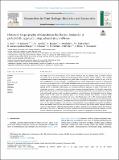Por favor, use este identificador para citar o enlazar a este item:
http://hdl.handle.net/10261/285222COMPARTIR / EXPORTAR:
 SHARE SHARE
 CORE
BASE CORE
BASE
|
|
| Visualizar otros formatos: MARC | Dublin Core | RDF | ORE | MODS | METS | DIDL | DATACITE | |

| Título: | Historical biogeography of Cannabis in the Iberian Peninsula: A probabilistic approach using palynological evidence |
Autor: | Rull, Valentí CSIC ORCID ; Burjachs Casas, Francesc; Carrión, José; Ejarque, Ana; López Sáez, José Antonio CSIC ORCID ; Luelmo Lautenschlaeger, Reyes CSIC ORCID; Ochando, Juan; Revelles, J.; Riera, S.; Rodríguez, S. | Palabras clave: | Cannabis Hemp Pollen Iberian Peninsula Pleistocene Holocene Cultivation Retting Dispersal Diffusion |
Fecha de publicación: | 30-nov-2022 | Editor: | Elsevier | Citación: | Perspectives in Plant Ecology, Evolution and Systematics 58: 125704 (2023) | Resumen: | [EN] The tempo and mode of colonization of the Iberian Peninsula (IP) by Cannabis sativa, its further internal spreading and the potential cultural and environmental factors involved remain unknown. The available continental-wide European meta-analyses using pollen and archeological evidence account for only a few IP sites, insufficient for a sound assessment. This paper presents a nearly comprehensive database of almost 60 IP sites with palynological evidence of Cannabis and analyzes the corresponding spatiotemporal patterns. The first scattered records of this pollen type date from the Middle and Upper Paleolithic (150–12 kyr BP) and would have entered the IP by maritime Mediterranean or terrestrial continental pathways, or both. A first burst of introductions, probably in a cultivated form, would have occurred during the Neolithic (7–5 kyr BP) using similar paths. Human participation in these Neolithic introductions remains unclear but cannot be dismissed. A period of reduced Cannabis arrivals (mostly via maritime pathway) occurred between the Chalcolithic and the Roman Epoch (4.5–2 kyr BP), when the innermost parts of the IP were colonized (Late Bronze). A second, likely anthropogenic, introduction acceleration took place in the Middle Ages (1.5 kyr BP onward) using the Mediterranean and the continental pathways. Maximum cultivation and hemp retting activity was recorded during the Modern Ages (16th-19th centuries), coinciding with the increased demand of hemp fiber to supply the Spanish royal navy for imperial expansion and commerce. A potential link between Cannabis colonization/introduction bursts and climatic warmings has been observed that should be tested with future studies. Regional moisture variations seem to be less influential. Further efforts to enhance and improve the database used in this study are encouraged. The results of this paper should be compared with archeological and historical evidence to clarify the role of human migrations and cultural changes in the historical biogeography of Cannabis in the IP. | Descripción: | Este artículo está sujeto a una licencia CC BY 4.0 | Versión del editor: | https://doi.org/10.1016/j.ppees.2022.125704 | URI: | http://hdl.handle.net/10261/285222 | DOI: | 10.1016/j.ppees.2022.125704 | ISSN: | 1433-8319 |
| Aparece en las colecciones: | (CCHS-IH) Artículos (IBB) Artículos |
Ficheros en este ítem:
| Fichero | Descripción | Tamaño | Formato | |
|---|---|---|---|---|
| Historical_biogeography.pdf | 6,02 MB | Adobe PDF |  Visualizar/Abrir |
CORE Recommender
SCOPUSTM
Citations
6
checked on 22-abr-2024
WEB OF SCIENCETM
Citations
5
checked on 24-feb-2024
Page view(s)
58
checked on 24-abr-2024
Download(s)
52
checked on 24-abr-2024
Google ScholarTM
Check
Altmetric
Altmetric
Este item está licenciado bajo una Licencia Creative Commons

